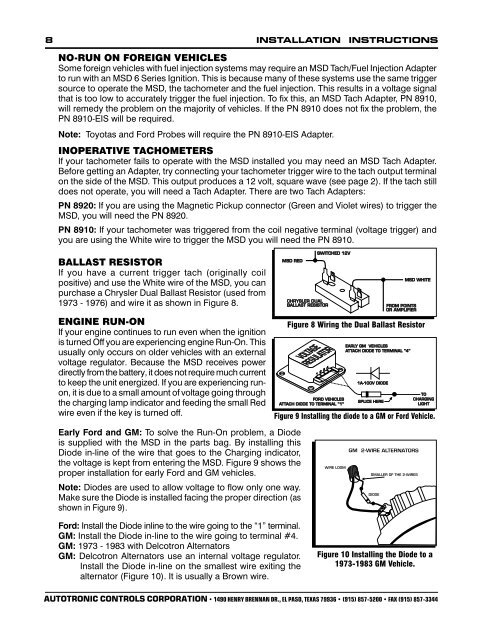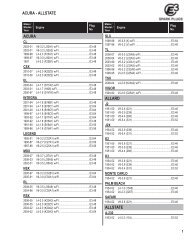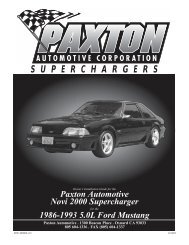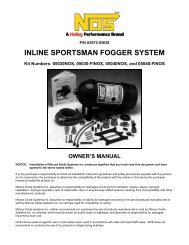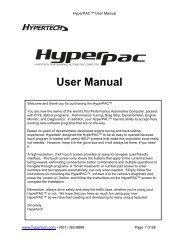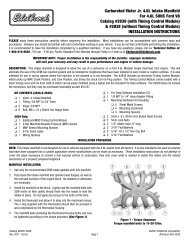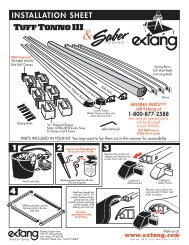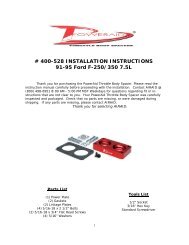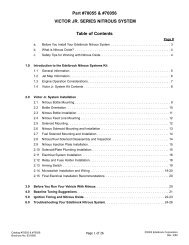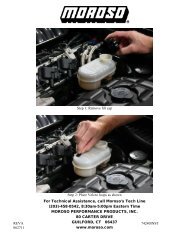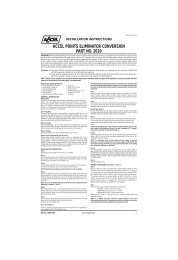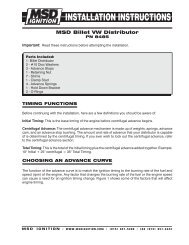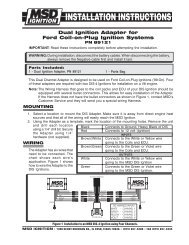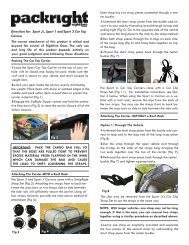MSD 6520 Ignition Kit Installation Instructions - Jegs
MSD 6520 Ignition Kit Installation Instructions - Jegs
MSD 6520 Ignition Kit Installation Instructions - Jegs
You also want an ePaper? Increase the reach of your titles
YUMPU automatically turns print PDFs into web optimized ePapers that Google loves.
INSTALLATION INSTRUCTIONS<br />
NO-RUN ON FOREIGN VEHICLES<br />
Some foreign vehicles with fuel injection systems may require an <strong>MSD</strong> Tach/Fuel Injection Adapter<br />
to run with an <strong>MSD</strong> 6 Series <strong>Ignition</strong>. This is because many of these systems use the same trigger<br />
source to operate the <strong>MSD</strong>, the tachometer and the fuel injection. This results in a voltage signal<br />
that is too low to accurately trigger the fuel injection. To fix this, an <strong>MSD</strong> Tach Adapter, PN 8910,<br />
will remedy the problem on the majority of vehicles. If the PN 8910 does not fix the problem, the<br />
PN 8910-EIS will be required.<br />
Note: Toyotas and Ford Probes will require the PN 8910-EIS Adapter.<br />
INOPERATIVE TACHOMETERS<br />
If your tachometer fails to operate with the <strong>MSD</strong> installed you may need an <strong>MSD</strong> Tach Adapter.<br />
Before getting an Adapter, try connecting your tachometer trigger wire to the tach output terminal<br />
on the side of the <strong>MSD</strong>. This output produces a 12 volt, square wave (see page 2). If the tach still<br />
does not operate, you will need a Tach Adapter. There are two Tach Adapters:<br />
PN 8920: If you are using the Magnetic Pickup connector (Green and Violet wires) to trigger the<br />
<strong>MSD</strong>, you will need the PN 8920.<br />
PN 8910: If your tachometer was triggered from the coil negative terminal (voltage trigger) and<br />
you are using the White wire to trigger the <strong>MSD</strong> you will need the PN 8910.<br />
BALLAST RESISTOR<br />
If you have a current trigger tach (originally coil<br />
positive) and use the White wire of the <strong>MSD</strong>, you can<br />
purchase a Chrysler Dual Ballast Resistor (used from<br />
1973 - 1976) and wire it as shown in Figure 8.<br />
ENGINE RUN-ON<br />
If your engine continues to run even when the ignition<br />
is turned Off you are experiencing engine Run-On. This<br />
usually only occurs on older vehicles with an external<br />
voltage regulator. Because the <strong>MSD</strong> receives power<br />
directly from the battery, it does not require much current<br />
to keep the unit energized. If you are experiencing runon,<br />
it is due to a small amount of voltage going through<br />
the charging lamp indicator and feeding the small Red<br />
wire even if the key is turned off.<br />
Early Ford and GM: To solve the Run-On problem, a Diode<br />
is supplied with the <strong>MSD</strong> in the parts bag. By installing this<br />
Diode in-line of the wire that goes to the Charging indicator,<br />
the voltage is kept from entering the <strong>MSD</strong>. Figure 9 shows the<br />
proper installation for early Ford and GM vehicles.<br />
Note: Diodes are used to allow voltage to flow only one way.<br />
Make sure the Diode is installed facing the proper direction (as<br />
shown in Figure 9).<br />
Figure 8 Wiring the Dual Ballast Resistor<br />
Figure 9 Installing the diode to a GM or Ford Vehicle.<br />
Ford: Install the Diode inline to the wire going to the “1” terminal.<br />
GM: Install the Diode in-line to the wire going to terminal #4.<br />
GM: 1973 - 1983 with Delcotron Alternators<br />
GM: Delcotron Alternators use an internal voltage regulator.<br />
Install the Diode in-line on the smallest wire exiting the<br />
alternator (Figure 10). It is usually a Brown wire.<br />
Figure 10 Installing the Diode to a<br />
1973-1983 GM Vehicle.<br />
AUTOTRONIC CONTROLS CORPORATION • 1490 HENRY BRENNAN DR., EL PASO, TEXAS 79936 • (915) 857-5200 • FAX (915) 857-3344


